Hetty McKinnon's guide to being a better vegetarian
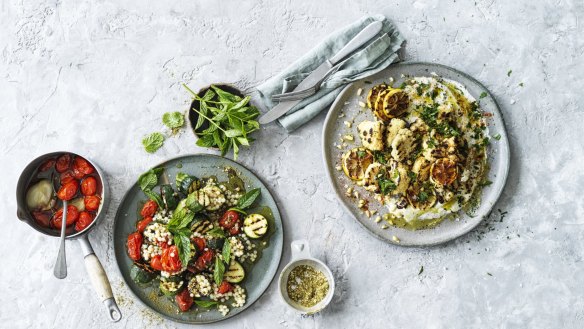
- Charred cauliflower salad with lemony whipped feta and pine nuts
- Grilled zucchini, zaatar and pearl cous cous salad with cherry tomato confit
As a longtime vegetarian who has never looked back nor missed meat, I relish the opportunity to share my true love of plant-based eating with others. A far cry from the days when vegetarians had to subsist on cheese and pasta, we are lucky to be living in the age of a vegetable renaissance, when the possibilities of vegetarian cooking are more exciting and diverse than ever before.
For those of us who grew up on the meat and three veg dinner, switching to a veg-centric diet can have its challenges and certainly requires a mental shift. Leaving behind meat, which is so often the heart of a meal, and re-centring your diet around vegetables or grains requires you to think more creatively and holistically about plants and how to use them to create a meal that is both hearty and satisfying.

My most useful piece of advice to budding vegetarians is to "transition" in stages. Don't feel the pressure to become vegetarian overnight. Introduce "Meatless Monday", be a weekday vegetarian, or subscribe to a flexitarian diet, where you can gradually incorporate more plant-based meals and days into your life.
It might feel like we are giving up something – meat! But in truth, a vegetarian diet is about more rather than less. My style of plant-based cooking has always been focused upon injecting food with more flavour, more texture, more layers of interest. Being vegetarian has made me more engaged with my food, cognisant of the seasons, and open to the borderless world of flavour. Here are some ideas on how to make being, or becoming, a vegetarian more exciting:
Reinvent your favourite "meaty" meals
I grew up eating meat, so many of my favourite comfort foods from childhood are not vegetarian. But I have discovered that it is actually quite easy to reinvent many of these meals without meat. For example, my mum's legendary cold jellyfish, celery and chicken salad can be reimagined with five-spice tofu and glass noodles. If you love chicken schnitzel, try crumbed eggplant, cauliflower or tofu. I've transformed my mother's sweet and sour pork into sweet and sour cauliflower. It's different, but no less delicious or comforting.
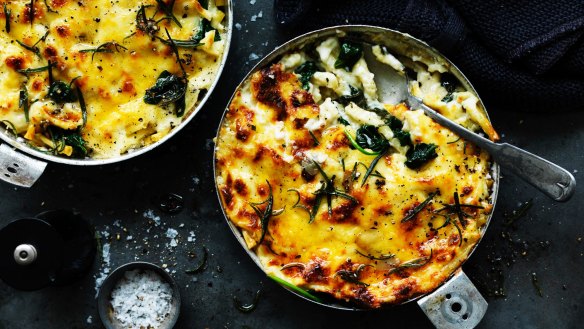
Love your veg
Vegetables are flavour – they hold the taste of the earth and are ready to soak up whatever seasonings you add. Yes, often it does take discipline to be a "good" vegetarian, one who has a healthy, balanced diet not too heavy on carbs or dairy. There are many clever ways to incorporate more vegetables into your meat-free meals. Try adding everyday vegetables like spinach, cauliflower, broccoli or sweet potato to family favourites like macaroni cheese, or chickpea curry, for example. Another trick is to add greens to your pasta sauce – blanch a bunch of kale or spinach and whizz this up with your pesto (store-bought or homemade). Better still, think of your vegetable as your sauce – blitzed peas make an excellent accompaniment to rice, while blended corn is a delicious, kid-friendly pasta sauce.
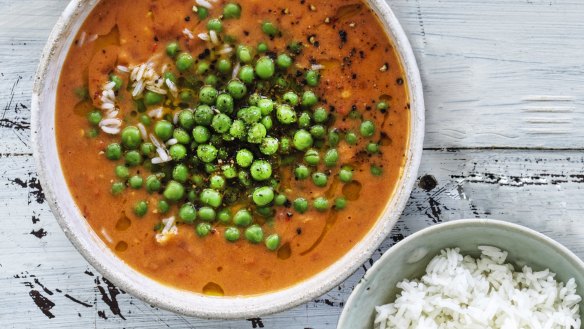
Embrace legumes
Beans and lentils are your allies in maintaining a healthy, delicious and satisfying vegetarian diet. Apart from being inexpensive and endlessly versatile, they are an essential way to add fibre, protein, carbohydrate, B vitamins, iron, copper, magnesium, manganese and zinc to your plant-based diet. The body uses carbohydrates in legumes slowly, providing steady energy for the body, helping you feel full and satiated after a meal. For this reason, beans feature heavily in my weeknight cooking. Crispy chickpeas, which have been roasted in the oven until crunchy, are one of my favourite ways to add heartiness to a salad. Smashed white beans, crushed with a clove of garlic, accented with a spice like cumin or coriander, and loosened with olive oil, is an excellent base for roasted vegetables.
If you have time, dried beans and legumes (chickpeas, cannellini beans, borlotti beans, black beans) are the best because you can cook them in a broth flavoured with garlic and salt; if you have it, add a piece of seaweed for extra umami. These brothy beans are a meal in themselves (the broth is delicious) but having a pot of cooked beans in the refrigerator is a great way to get a head start on weekday meal prepping. They can be roasted or smashed like I've described above, added to soups, salads or pasta. Of course, canned beans are also fine and are what I use most in weeknight cooking.
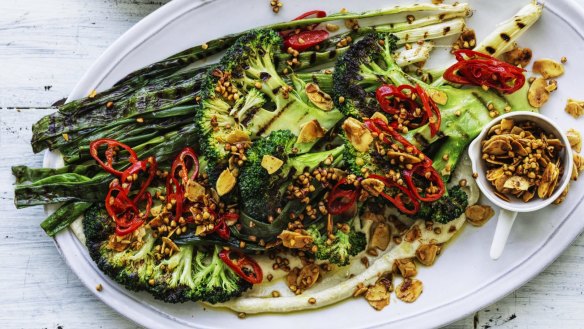
The way you cook it matters
When it comes to vegetables, the cooking method really matters. For those who grew up with insipid boiled vegies, you'll understand. Boiling rarely coaxes the maximum flavour from vegetables. Rather, char-grill (either on the barbecue or on the stovetop) to create smokiness, roast until sweet, or pan-fry for crispiness. Try grilling broccoli, you will be amazed by the results. For a celebratory dish, slow-roasting a whole cauliflower or cabbage creates a lovely contrast of sweet-smoky flavours – after an hour or longer in the oven, the internal flesh is melty and velvety, while the outside is charred. Also, remember that many vegetables can be consumed raw – fennel, asparagus, broccoli, carrot, Brussels sprouts, cabbage, snow peas, sugar snaps or beetroot can all be sliced or shaved, and used raw in salads or for snacking.
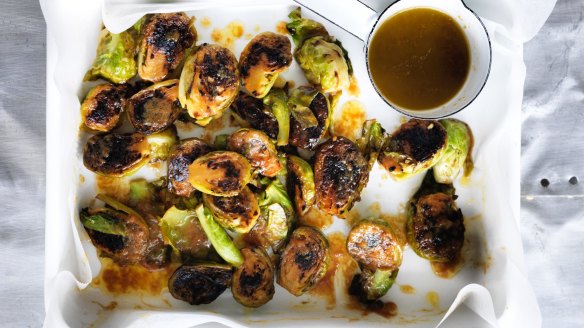
Invest in umami
For vegetarians, umami is usually the flavour we crave the most, and when you give up meat, it is often this "savouriness" that you will miss the most in your food. Umami ingredients such as miso paste, soy sauce, kimchi, aged cheeses, mushroom (fresh and dried), seaweed, green tea, tomato and garlic add depth and richness to your plate. A knob of miso added to brown butter makes an irresistible sauce for pasta or roasted vegetables, for example. When making a curry or dahl, add a chopped tomato – this will break down during cooking to inject a complex savoury note to the finished dish. Balsamic and wine vinegars are also excellent umami-enhancers – I add a swig of red wine vinegar to my tomato-based pasta sauce to bring brightness and concentrated flavour.
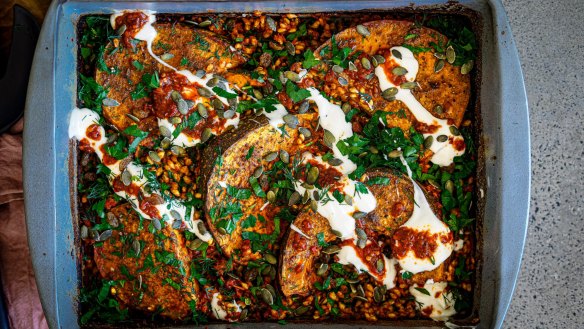
Spice it up
The lightbulb moment for me as a vegetarian cook was discovering spices. Spices transform vegetables, enhancing their earthiness, nuttiness, and sweetness. They allow the individual characteristics of the vegetable to shine, unleashing their innate flavours. Sprinkling some ground cumin or coriander on cauliflower, some ras el hanout on Brussels sprouts or a hint of cinnamon on pumpkin really lifts that vegetable to new heights.
Turn to tofu
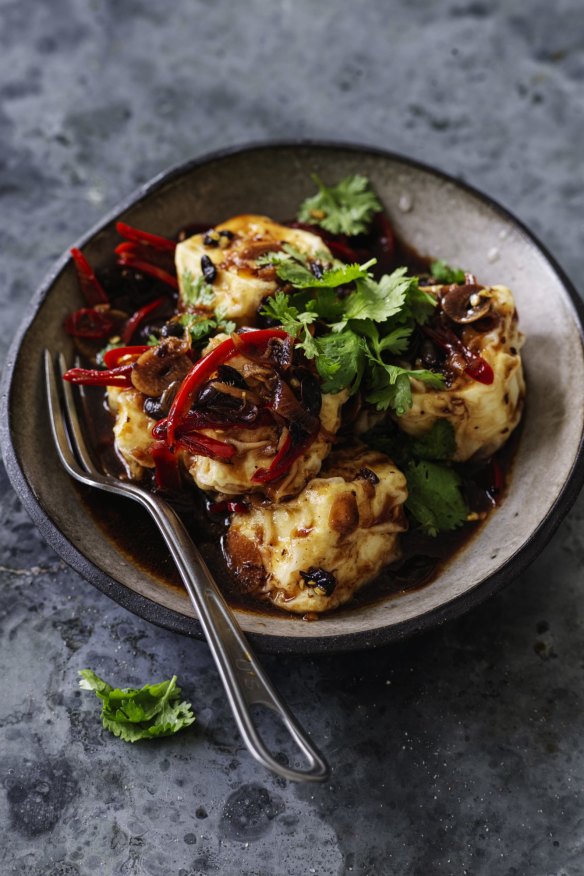
My love of tofu has been lifelong. Growing up in a Chinese household, tofu was an everyday food. We mainly ate silken tofu and it was usually steamed and topped with ginger-spring onion oil. Now, living in a predominantly vegetarian household, tofu is an essential source of protein, and adds meatiness to our meals. I use tofu in so many ways – in curries, salads, stir-fries, as the patty in burgers, and scrambled with spices as a filling for tacos. Crispy salt-and-pepper tofu is one of our beloved family meals, and mapo tofu is the spicy, salty dish from childhood that I crave. I even use silken tofu in desserts. The key thing to remember about tofu is that you need to season it generously. Tofu sucks up flavour and it thrives on big, punchy flavours. Remember this when you are cooking with it.
Aromatics
Garlic, onion, shallots and ginger are important in my vegetarian cooking. When cooked in oil, they release aromas and impart deep flavours into the dish being cooked. Aromatics can be used in different ways, depending upon the dish. If you are looking for subtle flavour, as you would for stir-fries, broths or noodle sauces, add the aromatics whole – simply bruise the garlic or ginger by smashing it with the flat side of a knife before adding it to hot oil (when the dish is ready, you can discard the aromatics). For a richer, more intense flavour, finely chop up your aromatics, making sure to add your onions to the pan first to let them get sweet and melty; when you add your garlic or ginger, which cooks and burns quickly, it's always a good idea to reduce the heat to low.
Hetty McKinnon is the famed cookbook author of Community. She will publish her fourth cookbook, To Asia With Love, in late September.
Fun fact: three out of five of our website's top recipes ever are vegetarian (Hellenic Republic's Cypriot grain salad, Adam Liaw's vegetarian stroganoff bake and Neil Perry's whole roasted cauliflower). So, at a time when concern over meat supply is fuelling an already spiking interest in all things vegetable, we decided to curate our Top 10 most popular vegetarian recipes of all time.
Appears in these collections
The best recipes from Australia's leading chefs straight to your inbox.
Sign upMore:
From our partners
Original URL: https://www.watoday.com.au/goodfood/tips-and-advice/how-to-be-a-good-vegetarian-20200806-h1pty0.html
